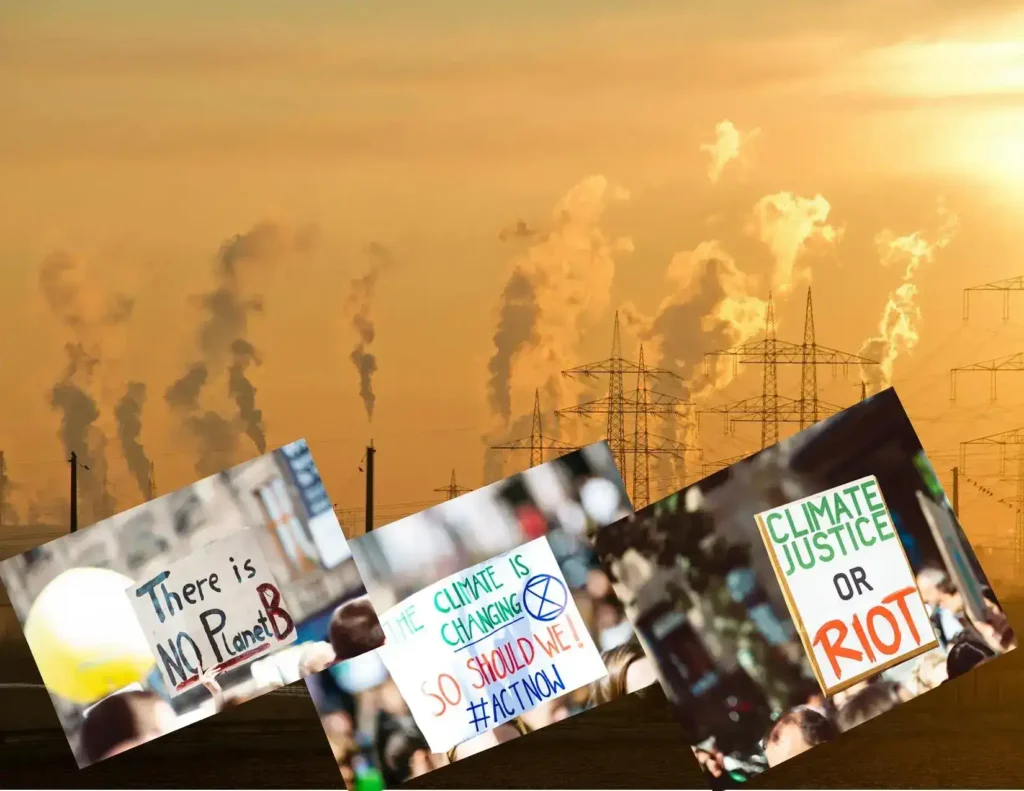
Understanding Paris Agreement A basic guide to understand Kyoto protocol Paris agreement and UNFCC www.agrieducation.pk climatechange carbontrading carboncredit carbonmarket carboncreditinpakistan.webp.webp
A Complete Guide to Understand The UNFCCC, The Kyoto Protocol and Paris Agreement
Formerly, the Paris Agreement was signed in 2015 but the story of it started long time ago back in the 1986.
History of Climate Change
Suante Erinos Discovers Global Warming
A Swedish scientist Suante Erinos first published the idea that burning fossil fuels can pump Carbon dioxide (CO2) levels so significantly that humans can cause global warming. This was the very first time that the idea of human activities causing climate change actually went public. But back then no one paid attention to his statement.
Contribution of Guy Stewart Callendar in Climate Change Study
In 1930s measurements show that average temperature of U.S and Northern Atlantic is increasing. But no one actually knew what the reason for. That maybe it’s a natural cycle, maybe it’s some regional climate event. At the same time another scientist published his point of view proving that those measurements already mean that climate change is underway. His name was Guy Stewart Callendar. He was an English team engineer and inventor who out of pure curiosity decided to dive into completely new topic of climate science. In the early 1930s, Callendar began collecting data on concentration and properties of the atmospheric gases on the rainfalls and temperatures across the globe on the role of the ocean currents and use of fossil fuels. As well among many other factors, as a result he produced the first ever draft of climate model; “the mathematical model simulating climate behavior” based on its core drivers. Even today scientists say that his calculations were surprisingly accurate.
But as you can imagine back then his research was not received too well. Members of Methodological Society basically ignored his proofs and calculations saying that the person with no relevant PhD could not be right on such a complex issue. But Callendar never gave up on his theory and kept working on it. Till late 1960s publishing more and more proofs. He became one of the most significant figures in discovery of climate change. Callendar’s study raised quite a lot of curiosity towards disability of climate change and scientific community and other scientists also continued to look into the topic. In the 1950s, this was first time when more broad Scientific Community went public saying that; we think climate change is really happening and we still don’t know the reason. Humans might be a reason but we don’t have proofs yet.
Contribution of James Hansen in Climate Change Study
Well, something was definitely happening, popularization and investigation of climate change continued on bigger scale now but no concrete actions to fight. It was taken till one notable moment on June 23, 1988. James Hansen one of the leading NASA scientists gave testimony to the U.S Senate committee on energy and natural resources. This testimony is considered to be the first call for action on the highest level. In his statement he not only confirmed that according to NASA computer simulations climate change is happening but he also highlighted that climate change is already really large enough to cause extreme weather events. With 99 percent certainty, it is caused by human actions. His statement made headlines around the world, for the first time started the real discussion between public scientists and politicians.
Establishment of U.N. Intergovernmental Panel on Climate Change (IPCC)
As one of the measures, United Nations established in the end of the same year, an organization called the Intergovernmental Panel on Climate Change (IPCC) that includes representatives from 195 countries whose goal is to have the most up-to-date information on the problem of climate change. Basically they review almost the every scientific information that is being produced in the world and build comprehensive picture based on those tons of reports. So what they do is actually tremendous work and this organization became a bigger stage for pushing the problem of climate change further. Because now at least governments have single source of truths, someone they can rely on in terms of trying to get more information on what’s going on.
The Rio Summit in the History
The next important milestone happened in June 1992. The Rio Summit is also called the Earth Summit, it was Major International United Nations Conference that brought together representative from 179 countries to discuss plan of actions to be taken globally to minimize negative human impact on the environment. For the first time in history climate change became one of the major problems on agenda of such an event. At conference was concluded a very crucial document called; United Nation Framework Convention and Climate Change (UNFCCC) which is said to be the parent document of the Paris Agreement.
Historical Facts about United Nation Framework Convention and Climate Change (UNFCCC)
Now let’s check some key facts. As I mentioned the U.N. convention document was signed in June 1992. It was ratified and just two years later the document defied. After the country signed, the document need to be approved with the key government bodies of that country. For example; in case of US, this would be US Senate. In the end, 197 countries redefined the convention. The purpose of the document was to make sure that countries sign under the words that climate change is a problem and countries have to considered actions to minimize their greenhouse gas emissions and make sure that the reduction of emissions will be enough to keep at safe level. But not all the countries necessarily had to take actions. It was decided that so far only developed countries are under obligation to minimize their greenhouse gas emissions.
First of all because back then they were responsible for the much bigger share of emissions those are already accumulated in the atmosphere and secondly because they have more financial technological and human resources to actually affect the problem. As for developing countries, it was decided that they can participate voluntarily if they want to and if not well then they can do nothing so far. The convention also suggested establishment of the financial mechanism to support developing countries in their fight with greenhouse gas emissions and with consequences of the climate change that they suffer from already. For example; most of African Countries heavily rely on agriculture and climate change already shuffled the rainfall patterns this brought much more floods into the regions. For its mitigation, they need to build much more resilient agricultural infrastructure. They also need to support regions in hunger caused by poor harvest and to do this they need financial resources that those countries do not have.
First Framework of Climate Justice
The projects launched a system of Grants and Loans through the fund that will be replenished every four years by almost 40 developed countries. This approach represents one of the principles of Climate Justice which states that; those countries that have benefited from the emissions in the form of ongoing Economic Development and increased wealth have an ethical obligation to share these benefits with countries who are today suffering from the effect of those emissions to implement the convention. Every country now had to develop the plan of actions to reduce their emissions and they had to report the results of those actions every year. But it’s also important to notice that the convention was not legally binding means that countries didn’t have any legal obligation to actually deliver on their commitments. But this was at least first attempt to align countries on something more concrete than just idea of climate change.
Rio Summit and the Kyoto Protocol
Five years later after the Rio Summit in December 1997 countries signed the first extension to the convention. It was called the Kyoto Protocol. It was a little bit more tangible. It finally had at least some numeric goals. Since the Kyoto Protocol was much more concrete. It was much harder to make countries implemented and it took seven years to ratify the agreement. By the time when it actually got ratified it was already outdated.
But let’s go step by step; the Kyoto Protocol got rectified in February 2005 in Kyoto, Japan during UNFCCC (COP3). The first commitment period when countries had to work towards achieving the objectives of the protocol was from 2008 to 2012. This time protocol got ratified by 193 countries and unfortunately United States didn’t join. At the time US was number one in greenhouse gas emitter in the world. United States was responsible for almost 25 percent of the old greenhouse gas emissions globally. According to protocol the goal for the developed countries was to reduce their greenhouse gas emissions by 5 times the level of 1990.
Read More: Part-2, The Paris Agreement on Climate Change and its Important
About Author: M. Safeer A. Jafrey (Chief Agribusiness Consultant) Agri. Education Pakistan (BinQain Agro Services)
Acknowledged and Awarded By; UNIDO | EDI | PSF | ADB | TiE | PU | ATDC | Member Acumen Global Foundry | EIT Food Alumni
References
- “Paris Agreement”. United Nations Treaty Collection. Archived from the original on 5 July 2021. Retrieved 15 July 2021.
- “Paris Climate Agreement Becomes International Law”. ABC News. Archived from the original on 4 November 2016. Retrieved 4 November 2016.
- UNFCCC. “The Paris Agreement”. unfccc.int. Archived from the original on 19 March 2021. Retrieved 18 September 2021.
- Schleussner, Carl-Friedrich. “The Paris Agreement – the 1.5 °C Temperature Goal”. Climate Analytics. Retrieved 29 January 2022.
- Corder, Mike (20 December 2019). “Activists cheer victory in landmark Dutch climate case”. AP news. Archived from the original on 9 July 2021. Retrieved 2 July 2021.
- Boffey, Daniel (26 May 2021). “Court orders Royal Dutch Shell to cut carbon emissions by 45% by 2030”. The Guardian. Archived from the original on 26 May 2021. Retrieved 26 May 2021.
- “Paris Agreement, FCCC/CP/2015/L.9/Rev.1” (PDF). UNFCCC secretariat. Archived (PDF) from the original on 12 December 2015. Retrieved 12 December 2015.
- “UN Climate Talks”. Council of Foreign Affairs. 2021. Archived from the original on 20 July 2021. Retrieved 20 July 2021.
- Harrabin, Roger (8 December 2012). “UN climate talks extend Kyoto Protocol, promise compensation”. BBC News. Archived from the original on 16 July 2018. Retrieved 22 June 2018.
- Falkner, Robert (2016). “The Paris Agreement and the new logic of international climate politics”. International Affairs. 92 (5): 1107–1125. doi:10.1111/1468-2346.12708. ISSN 0020-5850. Archived from the original on 3 June 2018. Retrieved 7 March 2021.
- Klein, Richard J. T. (7 December 2020). “The Paris Agreement and the future of climate negotiations”. Stockholm Environment Institute. Archived from the original on 18 July 2021. Retrieved 18 July 2021.
- McGrath, Matt (19 February 2016). “UN climate chief Christiana Figueres to step down”. BBC News. Archived from the original on 29 December 2020. Retrieved 7 March 2021.
- Orangias, Joseph (1 April 2022). “The Nexus between International Law and Science: An Analysis of Scientific Expert Bodies in Multilateral Treaty-Making”. International Community Law Review. doi:10.1163/18719732-bja10068. S2CID 248057340.
- “UNFCCC:Ad Hoc Working Group on the Durban Platform for Enhanced Action (ADP)”. Archived from the original on 2 August 2015. Retrieved 2 August 2015.
- Jepsen, Henrik; et al. (2021). Negotiating the Paris Agreement: The Insider Stories. Cambridge University Press. ISBN 978-1-108-88624-6.
- Goldenberg, Suzanne (12 December 2015). “Paris climate deal: nearly 200 nations sign in end of fossil fuel era”. The Guardian. Archived from the original on 26 July 2021. Retrieved 18 July 2021.
- Evans, Simon (7 September 2015). “Bonn climate talks ask for draft Paris text”. Carbon Brief. Archived from the original on 18 July 2021. Retrieved 18 July 2021.
- “The Paris Agreement is done! Let the negotiations begin?”. GHG and Carbon Accounting, Auditing, Management & Training | Greenhouse Gas Management Institute. 24 February 2016. Archived from the original on 22 July 2021. Retrieved 22 July 2021.
- “How a ‘typo’ nearly derailed the Paris climate deal”. the Guardian. 16 December 2015. Archived from the original on 22 July 2021. Retrieved 22 July 2021.
- Sutter, John D.; Berlinger, Joshua (12 December 2015). “Final draft of climate deal formally accepted in Paris”. CNN. Cable News Network, Turner Broadcasting System, Inc. Archived from the original on 12 December 2015. Retrieved 12 December 2015.
- Watts, Joshua; Depledge, Joanna (2018). “Latin America in the climate change negotiations: Exploring the AILAC and ALBA coalitions”. WIREs Climate Change. 9 (6). Bibcode:2018WIRCC…9E.533W. doi:10.1002/wcc.533. S2CID 134228301. Archived from the original on 15 July 2021. Retrieved 15 July 2021.
- Harvey, Fiona (8 December 2020). “The Paris agreement five years on: Is it strong enough to avert climate catastrophe?”. The Guardian. Archived from the original on 15 July 2021. Retrieved 15 July 2021.
- “‘Historic’ Paris climate deal adopted”. CBC News. CBC/Radio Canada. 12 December 2015. Archived from the original on 12 December 2015. Retrieved 12 December 2015.
- “Article 20(1)” (PDF). UNFCCC.int. Archived (PDF) from the original on 17 November 2017. Retrieved 17 November 2017.
- Jump up to:a b Yeo, Sophie (19 April 2016). “Explainer: The adoption, signing and ratification of the UN climate deal”. Carbon Brief. Archived from the original on 8 May 2021. Retrieved 8 May 2021.
- Voigt, Christina (2017). “Institutional Arrangements and Final Clauses”. In Klein, Daniel (ed.). The Paris Agreement on Climate Change. p. 363.
- McGrath, Matt (31 March 2016). “Paris Climate Treaty: ‘Significant step’ as US and China agree to sign”. BBC. Archived from the original on 23 April 2016. Retrieved 23 April 2016.
- Davenport, Coral (31 March 2016). “Obama and President Xi of China Vow to Sign Paris Climate Agreement Promptly”. The New York Times. Archived from the original on 21 February 2017.
- “‘Today is an historic day,’ says Ban, as 175 countries sign Paris climate accord”. United Nations. 22 April 2016. Archived from the original on 29 June 2017. Retrieved 29 June 2017.
- “PARIS AGREEMENT Signature Ceremony” (PDF). UNFCCC. 22 April 2016. Archived from the original (PDF) on 16 May 2017. Retrieved 22 April 2016.
Source link
2024-02-14 02:27:46
Karl Hoffman is a distinguished agriculturalist with over four decades of experience in sustainable farming practices. He holds a Ph.D. in Agronomy from Cornell University and has made significant contributions as a professor at Iowa State University. Hoffman’s groundbreaking research on integrated pest management and soil health has revolutionized modern agriculture. As a respected farm journalist, his column “Field Notes with Karl Hoffman” and his blog “The Modern Farmer” provide insightful, practical advice to a global audience. Hoffman’s work with the USDA and the United Nations FAO has enhanced food security worldwide. His awards include the USDA’s Distinguished Service Award and the World Food Prize, reflecting his profound impact on agriculture and sustainability.





